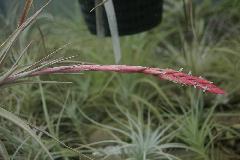
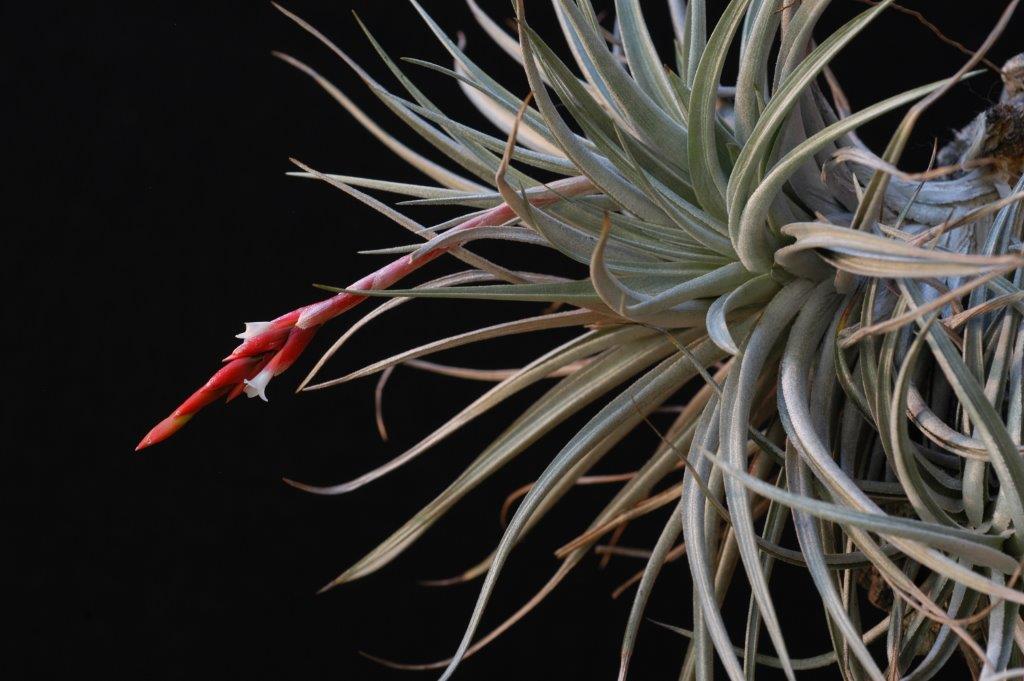
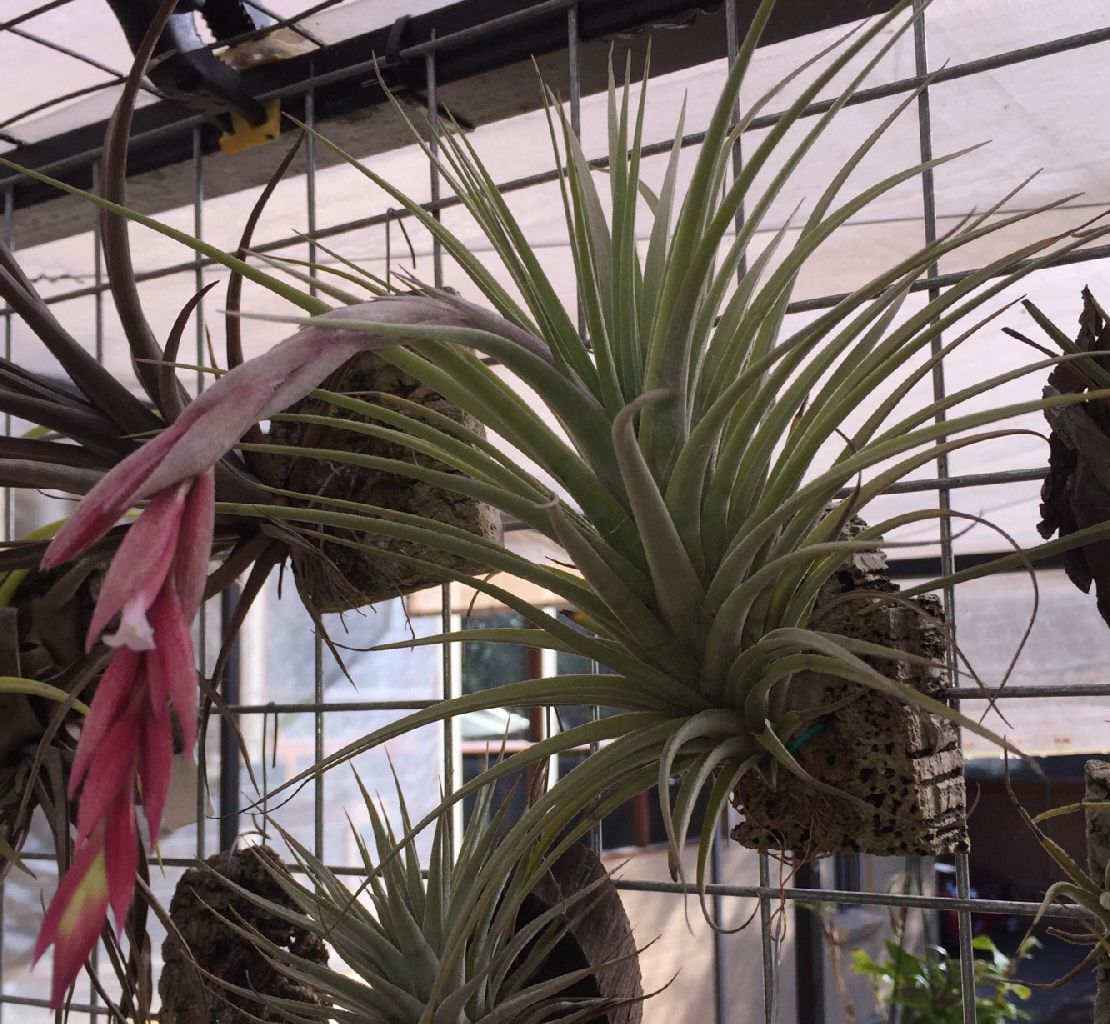
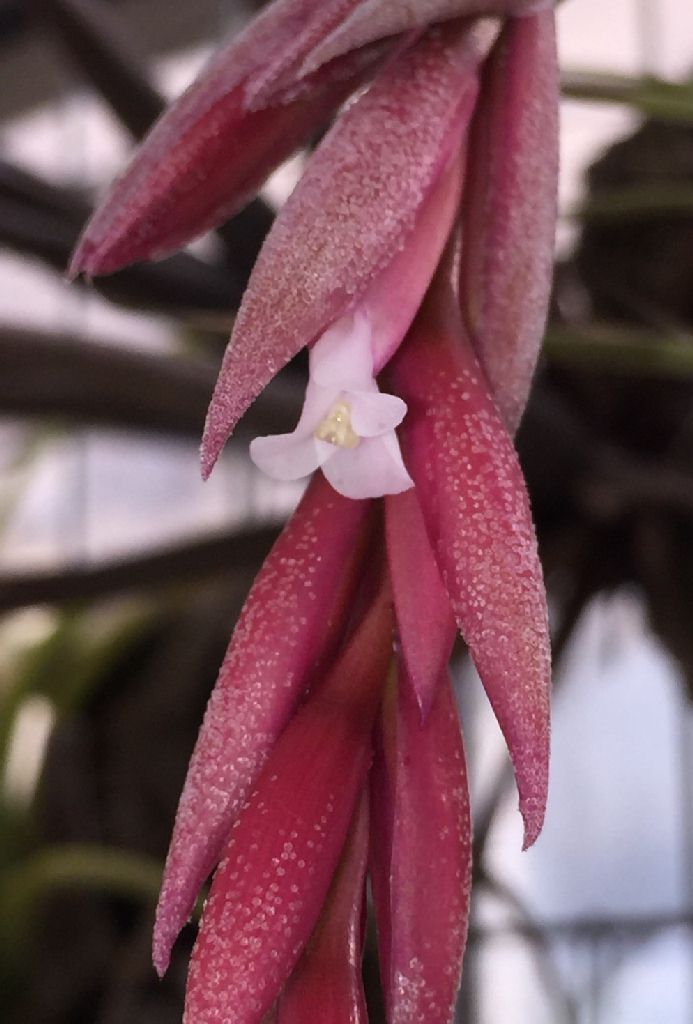
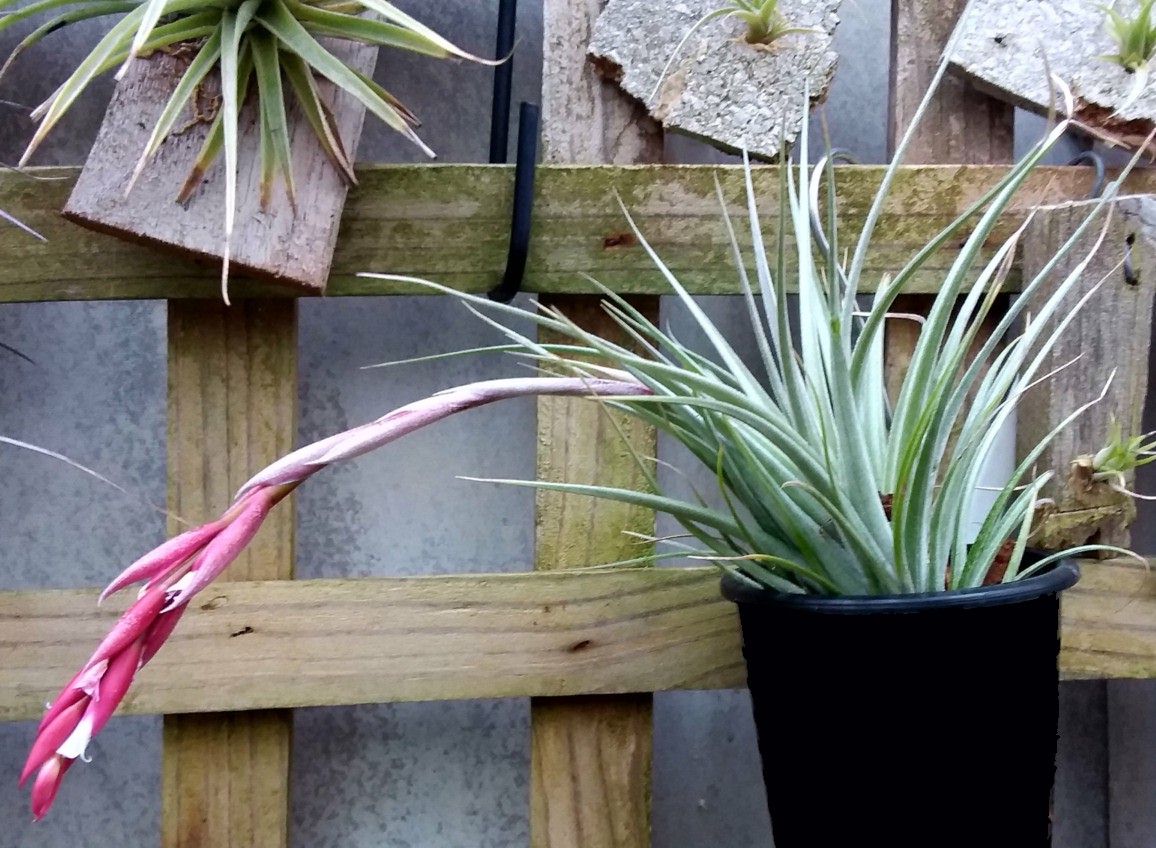
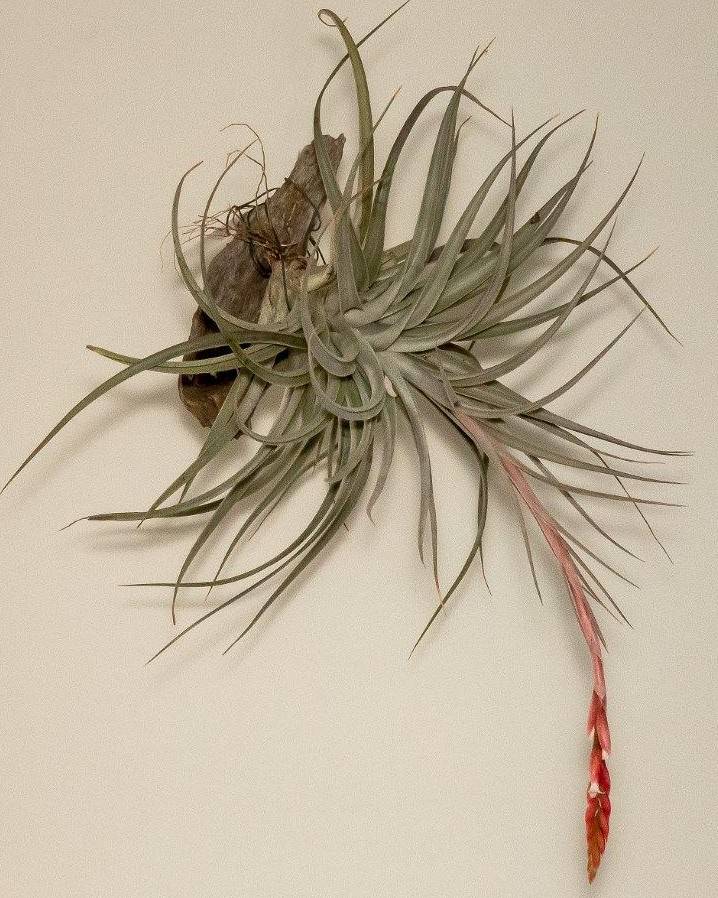
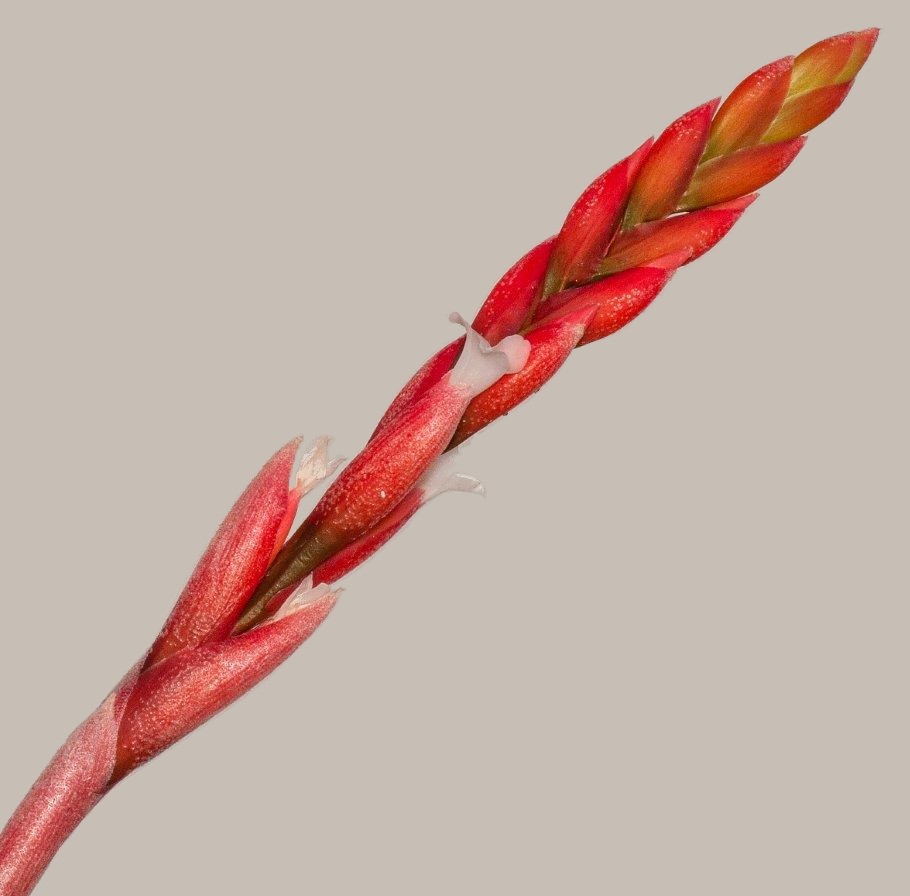
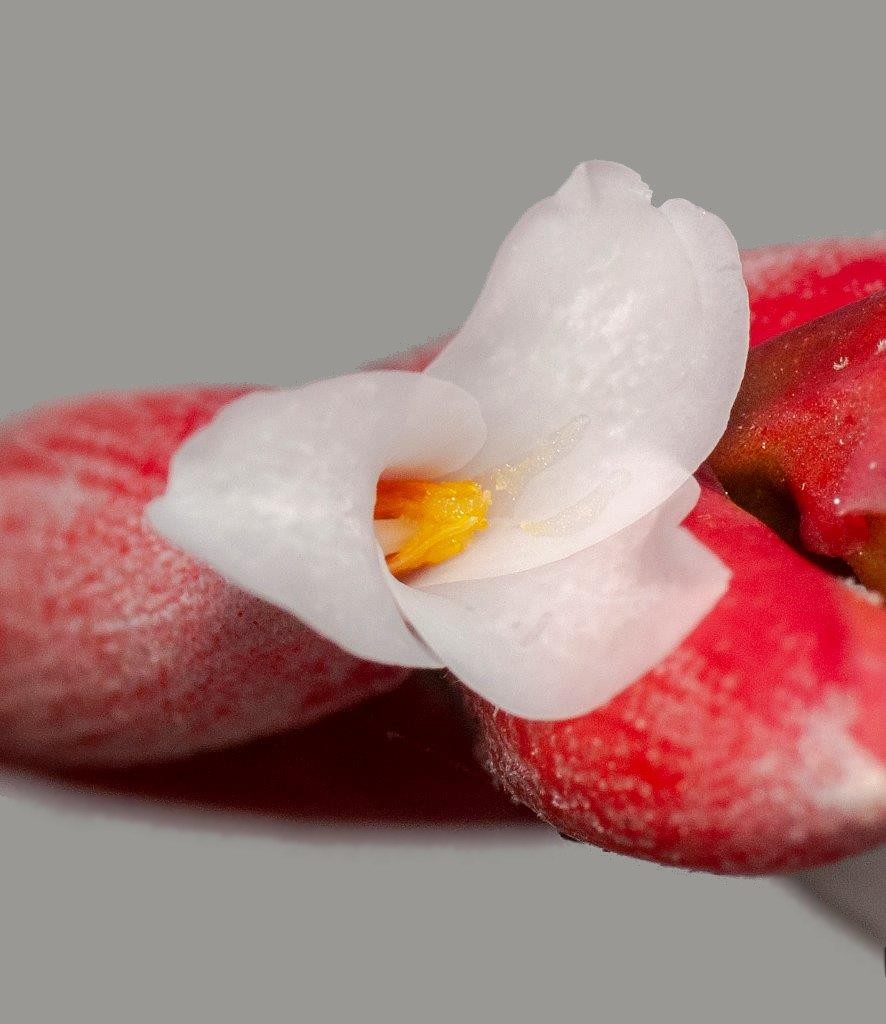
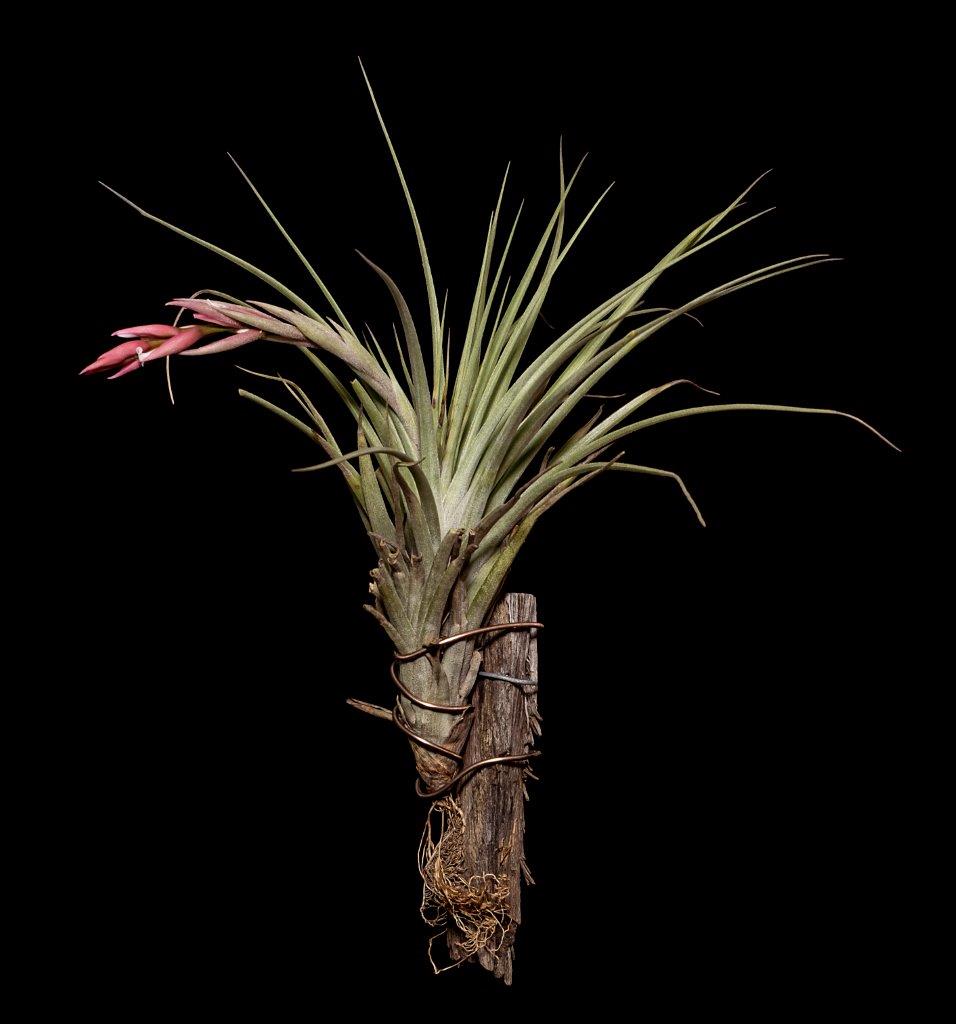
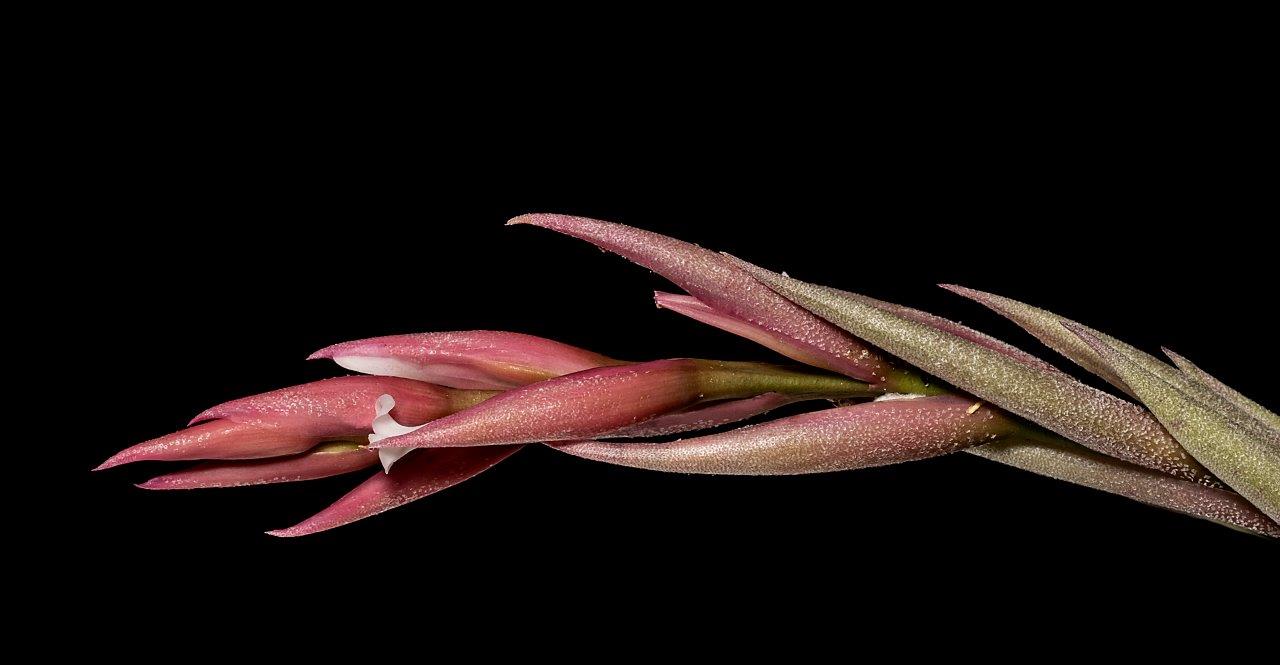
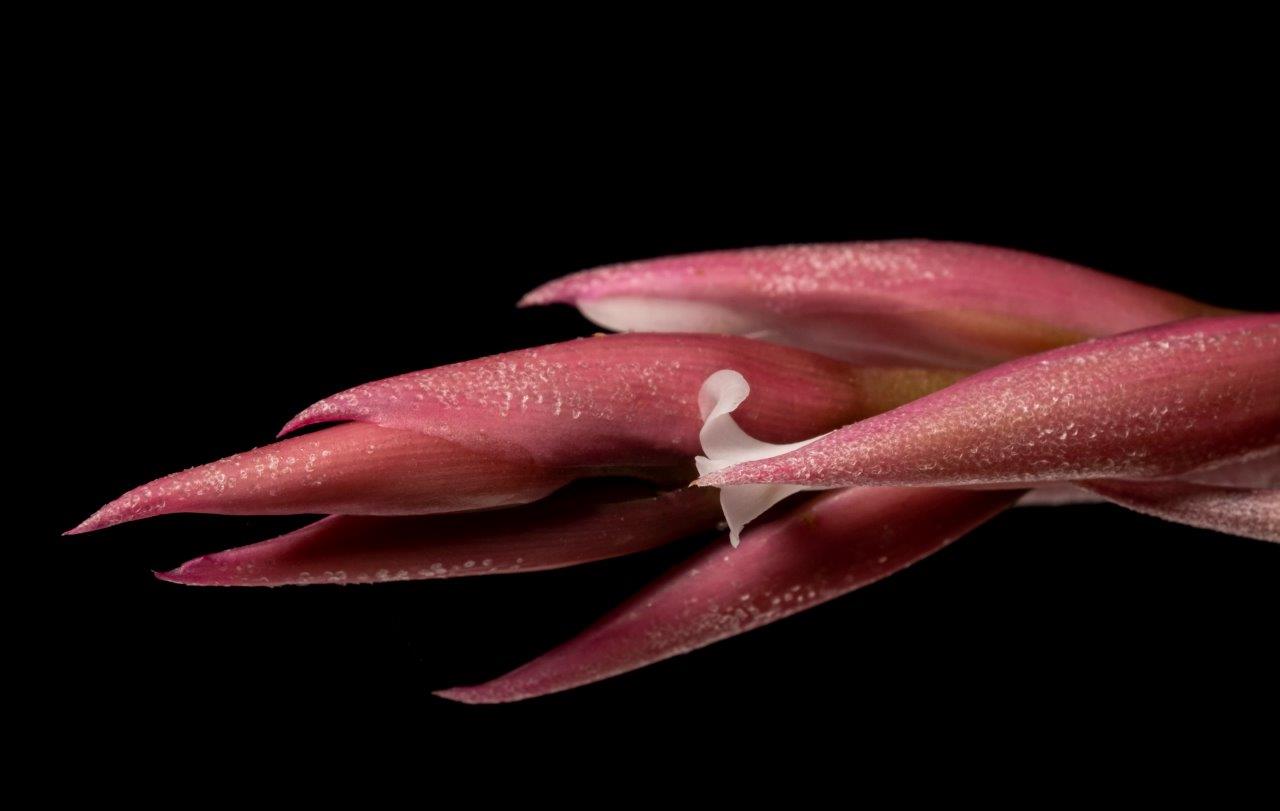
Translated from the German by Butcher
PLANT Growing in large clumps, stemless to short stemmed, flowering to 30-35cm high. Leaves numerous in a dense rosette, 20cm high, 25cm wide.
LEAF SHEATH Longish, to 2.5cm long, 2cm wide, indistinct, both sides with dense appressed scales, lighter than the blade which is 12-17cm long and 2-2.5cm wide next to the sheath, long attenuate, rolled inwards, outside weakly keeled, both sides with dense silver-white appressed scales, scales asymmetric, the edges with winged scales.
SCAPE Erect to mildly bent over, to 15cm long, 5mm wide, as long or shorter than the leaf rosette, densely covered by the stem bracts, the bottom stem bracts leaflike with spreading out blades, the upper ones erect with a short tip, with pink sheath densely appressed scaled.
INFLORESCENCE Bipinnate.
PRIMARY BRACTS short tipped, 2.5cm long, weakly nerved, carmine-red, the bottom greenish.
SIDE SPIKES 1 - 2, strongly reduced, sessile to short stalked, 2-3 (6) flowered, often only a single flower,
CENTRE SPIKE to 8.5cm long, 1.5cm wide, lancelike, complanate, to 15 flowered.
FLOWER Relatively small, subsessile, beginning dense, later lax upright, green, flat edged, naked, flexuous rhachis is visible.
FLOWER BRACT Distichous, long-elliptic, ca 15mm long, blunt to acuminate, not keeled, the bottom greenish, scarcely scattered lepidote at the tip, when fresh indistinctly nerved, a little bit shorter than the sepals, membranous edges.
SEPALS Pale red, membranous, the posterior ones lightly keeled, with the base free, to 15mm long, 6mm wide, bare, not nerved.
PETALS Tongue-shaped, light violet to white, with bent back platte, 15-20mm long, 3mm wide.
STAMENS & STYLE Included. Filament in the upper third strongly pleated. Style with white lobes a little longer than the anthers.
OVARY green.
HOLOTYPE B.G. H. 54 925, leg. D Muhr, s.n. (Jan 1984), HEID
HABITAT Actual location unknown, Prov. Jujuy.
Differs from T. vernicosa in:-
1 - Upper scape bracts acuminate not rounded.
2 - Side spikes greatly reduced often to a single flower.
3 - Insertion of the base of the flower seems to be in a spiral.
4 - Floral bracts at anthesis laxly inserted.
5 - Rhachis strongly angular-complanate and visible.
6 - Petal blade spreading not erect.
T. guelzii was known as T. ixioides Grisebach by Mrs. D. Muhr, Jujuy, Argentina, and the Bromeliad nurseryman Gulz at Bad Vilbel. The plant was therefore named after grower Hans Gulz. It was sent in February 1984 to the Botanical garden of the University of Heidelberg where it already has flowered several times. The bipinnate inflorescence is characterized by the basal side spikes being strongly inhibited in their development, reaching at most 1-2 cm long, usually only 2 - 3 -, rarely up to 6-flowered, often reduced to a single flower, and then the base of the end spike becomes as though spiral flowering,( fig. 36, left and middle). This behavior is constant and could be seen in several successive flowering periods on different plants.
Translated from the German by Butcher
PLANT- Epiphytic, very short stemmed, flowering to 30cm high, single or in groups.
LEAF - Numerous, rosette, erect, the outside ones widening out, moreover some parts secund, very stiff, both sides with dense appressed grey scales.
LEAF SHEATH - Indistinct, triangular, 25mm wide, inperceptibly merges with the blade, the edges strongly bent, at the bottom almost translucent.
LEAF BLADE - Thin lance-like, long acuminate, to 16cm long, 12-14mm wide (above the sheath) green, yet silver grey because of dense appressed indument on both sides, the edges bent and with very small erect asymmetrical scales.
SCAPE - Erect or bent, to 10cm long, ca 3mm diameter, naked.
SCAPE BRACT - Densely imbricate, longer than the internode, extensely cover the stem and adjacent to (stem therefore not visible), longish elliptic, the bottom with longer blades, the upper with short tips, then similar to the flower bracts, thin membranous, nerved, inner naked, outside with dense grey scales, pink.
INFLORESCENCE - Much exceeds the leaves, simple, drawn together on the sides, 7-9cm long, 10-12mm wide with 8-10 (-17) almost sessile, scentless flowers. (the bottom 2 or 3 seem to be polystichous, the upper distichous).
RHACHIS - Thin and bent, edged, naked, in a fresh state totally covered, when dry visible.
FLOWER BRACT - 12-17mm long, to 14mm wide in some cases but mainly ca. Smm wide, broad oval, tipped, red, leathery, in a fresh state bare, when dry weakly nerved, not keeled or (particularly the lower) weak and double keeled, the inner naked, outside of the lower ones dense and wholely covered, the upper ones and tips laxly scaled, the lower ones almost as long as the sepals, the upper ones 1-2mm shorter.
SEPAL - with the exception of the tips, enclosed by the flower bracts (12-) 13-15mm long, ca 6mm wide, 2-3mm high, uniformly joined together, acuminate, red, at the base green, naked, more or less nerved, thin membranous, edges translucent, the back pair keeled.
PETAL - White, making an erect tube, thin tongue shaped, the tips bent outwards and the whole of the edges weakly wavy. 16-22mm long, 4mm wide.
STAMENS - Deeply enclosed in the throat, filaments shorter than the style, white 8mm long, flat thin, straight, not pleated, 1mm wide.
Anthers 3-4mm long, 0.5mm wide, fixed at the bottom, the bottom wide the tips tapering, yellow, firmly stuck together.
OVARY - Green, oval, or almost globose, to 4mm long and 3mm diameter. Style 11mm long, erect or lightly spreading, papillose.
HOLOTYPE – leg R Ehlers P7953 (WU), July 1979
HABITAT - North PERU, Dept. Cajamarca, Rio Chamaya valley near Pucara, 1200m, epiphytic on trees.
DIFFERS FROM T. DIDISTICHA IN THAT
1 - Simple inflorescence and leathery flower bracts
2 - Bracts lightly carinate, almost smooth, wider, the back angled to curved, for the most part subglabrous.
3 - Filaments erect not plicate.
DIFFERS FROM T. LORENTZIANA IN THAT
1 - Leaves appress lepidote.
2 - Inflorescence simple.
3 - Floral bracts wider and stiffer.
4 - Petals smaller.
5 - Filaments not plicate.
DIFFERS FROM T. CAULIGERA
1 - Very rigid, succulent appressed lepidote leaves.
2 - Stem absent.
3 - Scape much shorter.
4 - Floral bracts for the most part subglabrous.
5 - Petals white.
In July 1979 I drove with 3 friends in northern Peru over the Olmos Valley towards Rio Chamaya. In this area, Prof. Rauh on earlier travels had discovered many interesting Tillandsias, including T. cacticola and T. hildae. How small the world for plant collectors sometimes is, on this remote and poor dust road. When we were there collecting gloriously flowering T. cacticola and T. latifolia var. divaricata, we saw a landrover on a mountain road. We went down quickly and to our delight and amazement, it was Prof. Rauh with Wolfgang Krahn from Stuttgart and Klaus von Bismarck – of course the greeting was great.
Two days later, near Pucara on the Rio Chamaya on high trees on the river, I collected tillandsias, including this newly described T. pucaraensis.
We now go back to 1964! In that year Wolfgang Krahn did a collecting trip from Cochabamba to Santa Cruz in Bolivia when his main interest was Cactaceae. It is noted that numbers 192 and 193 were Tillandsia and collected at km305 at 1560m. No.192a and c were identified as Diaphoranthema but 192b remained as an unknown. No.193 was identified as T. didisticha.
All these plants went to Alfred Blass. Some were further distributed including 192b. It is thought that some went to Renate Ehlers (she can’t remember, possibly because these were her ‘cactus’ days), Rauh at Heidelberg and the Linz Bot Garden. It is from the Linz Bot Garden that we get our clue because they have a specimen marked K192b. This plant has not been dissected to my knowledge but had been identified as T. guelzii by Lieselotte Hromradnik and only recently has she changed her name to T. pucaraensis. Note that this plant was in the collection of Blass for many years and could well have been the plant that got to Rauh instead of the alleged T. ixioides. If this is the case then it would make the type locality in Bolivia instead of Argentina. Dissection of K192b would be a great help in solving this mystery.
Let us now look at plants collected in Peru. In 1996 Butcher and Colgan bought plants called T. pucaraensis from Isley in the USA. Colgan flowered his plant which he says is the same as his alias ‘T. guelzii’ from Lydia but the plant has since died. Butcher’s plant did not die but has NOT yet flowered! At the time of purchase, after intense questioning, Paul Isley said the plant came from Peru where he had a collector (not Knize) operating. It seemed to be a bit hush hush! He knew no other detail. There is no link with the Koide plant T321. The identification of this T. pucaraensis could only have come from the Ehlers naming because T. guelzii was thought to be a different plant from a different area.
The holotype for T. pucaraensis P7953 was found in 1979 in Peru but not described until 1989. It is not certain which plants may have been distributed elsewhere – for example Heidelberg Bot Garden but as far as we can trace there are no specimens living at 2005. Heidelberg Incoming plant register for probably 1979 shows 54925a Till. pucaraensis Ehlers as a later added entry (?when added). But no plant 54925a is surviving at 2005 at Heidelberg.
In 1979 when T. pucaraensis was found, Renate's group did cross paths with a group comprising Krahn and Rauh. In 1979 we know that Krahn collected in Peru and brought back six Tillandsia/Vriesea for Heidelberg. One of these, WK 595 became Tillandsia krahnii but another one called 50882 Till. nov. spec.? WK666, 1600m., L. Aricapampa is not alive as at 2005. Can this be linked to Renate’s collection in the same year?
While there appears to be some justification that these plants are synonymous the problem of distant habitats still remains. It is odd that neither taxon has been collected since. Is it a hybrid? Some say it has links to T. didisticha which is found in Bolivia and not in Peru and was used as a differential by Renate for her T. pucaraensis. Others take the side of Rauh in seeing similarities with T. vernicosa. Will it ever be found again in the wild?
This problem has been caused mainly by the length of time it took from collection of the plant to formal description. We know how easy it is to get labels mixed up in Botanic gardens and plant nurseries. I certainly know that I am guilty in mislabelling my own plants only to correct my mistake at a later date. So often are you doing a job and get distracted. To err is human! However, mislabelling is still rare and for it to happen twice and link all to a single collection (K192b) by Krahn in 1964 is very hard to imagine indeed. It would be so easy to consider T. pucaraensis and T. guelzii as synonymous if their collection areas were close to each other but to my mind the jury is still out.
I leave it to the academic taxonomists to make any formal judgements regarding synonymy.
I would like to thank Renate Ehlers, Lieselotte Hromradik, Pam Koide, David Sheumack, Timm Stolten, Paul Isley and Len Colgan for their indulgence and help.